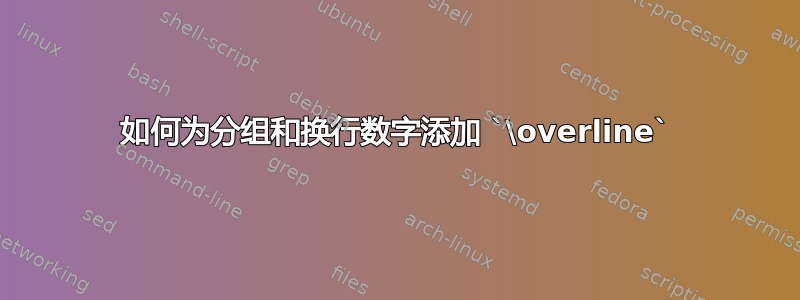
我有一个后续问题 https://tex.stackexchange.com/a/522907/46023
是否可以添加\overline用于分组和换行数字的命令?
也许可以\overline从某个数字得到,比如说
$23.456\overline{78910}$?
\documentclass[]{article}
% \groupify{<digits>}{<my number>}
% https://tex.stackexchange.com/a/522907/46023
\usepackage{xparse}
\ExplSyntaxOn
\NewExpandableDocumentCommand \groupify { O{\,\allowbreak} m m }
{ \jakob_groupify:nnn {#1} {#2} {#3} }
\cs_new:Npn \jakob_groupify:nnn #1 #2 #3
{ \__jakob_groupify_loop:nnw { 1 } {#2} #3 \q_recursion_tail {#1} \q_recursion_stop }
\cs_new:Npn \__jakob_groupify_loop:nnw #1 #2 #3
{
\quark_if_recursion_tail_stop:n {#3}
\exp_not:n {#3}
\int_compare:nNnTF {#1} = {#2}
{ \__jakob_groupify_sep:n }
{ \exp_args:Nf \__jakob_groupify_loop:nnw { \int_eval:n { #1+1 } } }
{#2}
}
\cs_new:Npn \__jakob_groupify_sep:n #1 #2 \q_recursion_tail #3
{
\tl_if_empty:nF {#2} { \exp_not:n {#3} }
\__jakob_groupify_loop:nnw { 1 } {#1}
#2 \q_recursion_tail {#3}
}
\ExplSyntaxOff
\begin{document}
\section{Without overline: Good}
$x=452.\groupify{3}{353602874713526624977572470936999
59574966967627724076630353547594571382178525
166427427466391932003059921817413596629043572
9003342952605956307381323286279434907632338298807531952
510190115738
3418793070215408914993}$
\section{With overline: Bad}
$x=452.353602874713526624977572470936999
59574966967627724076630353547\overline{\groupify{3}{594571382178525
166427427466391932003059921817413596629043572
9003342952605956307381323286279434907632338298807531952
510190115738
3418793070215408914993}}$
\section{Simple example for the target}
$x = 23.456\overline{78910}$
\end{document}
答案1
对于 LuaLaTeX 来说,有一个巧妙的解决方案,使用luacode和umoline。我改编了 Lua 代码https://stackoverflow.com/a/39481287/11954069
%!TEX program = lualatex
\documentclass{article}
\usepackage{luacode}
\usepackage{umoline}
\begin{luacode*}
function splitByChunk(text, chunkSize)
local s = {}
for i=1, #text, chunkSize do
s[#s+1] = text:sub(i,i+chunkSize - 1)
end
tex.print([[\Overline{%]])
for i,v in ipairs(s) do
tex.print(s[i])
end
tex.print([[}]])
end
\end{luacode*}
%The first argument is the number; the second is the chunk size
\newcommand{\DirtyOverline}[2]{%
\directlua{
splitByChunk("#2",#1)
}%
}
\begin{document}
\DirtyOverline{3}{54487755314354687344656897842}
\end{document}
抱歉,我不会说expl3,我认为这是一种非常繁琐的语言。




